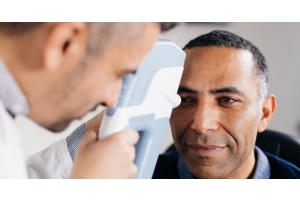
Also known as eyelid twitching, benign essential blepharospasm is a very rare condition. In fact, an estimated 2,000 people are diagnosed with the condition every year. While blepharospasm may start out as random eye twitching, it can progress to the point where you may not be able to keep your eyes open. The condition doesn't impact your vision, but it can lead to functional blindness. For additional clarity, let's take a closer look at blepharospasm.
What Is Blepharospasm?
Blepharospasm is a neurological condition that causes the muscles around the eyelids to contract uncontrollably. This leads to spasms of the upper and lower eyelid, as well as those surrounding it. It can lead to an inability to open or close one's eyes, making them very irritated and dry.
Do I Have Blepharospasm If My Eyelids Twitch?
Benign essential blepharospasm is very rare. And several factors can cause eyelid twitching, such as lack of sleep, dry eye, stress, and too much caffeine. Other times eyelid twitching can be associated with conditions like Tourette syndrome, Meige syndrome, and Parkinsons. At the same time, eye twitching can be a side effect of certain medication. You should, however, speak to your eye care professional if:
What Are the Causes of Blepharospasm?
Blepharospasm occurs when the portion of the brain that controls the eyelid muscles stops properly working. In many instances, the condition is genetic. And women who are aged between 40 to 60 are more likely to develop it.
For the most part, however, the underlying causes of benign blepharospasm are unknown. Most researchers agree it's caused by a combination of environmental and genetic factors. More so, certain genetic conditions can increase the likelihood of developing blepharospasm, and environmental factors can trigger the symptoms and signs in those who are at risk.
A few common factors associated with causing or worsening blepharospasm are:
What Are the Symptoms of Blepharospasm?
Blepharospasm usually starts gradually but may begin suddenly. It can occur at any age after a person has had their first blink reflex or even in newborns within the first month of life. The most common symptoms include:
Oromandibular Dystonia
In some instances, blepharospasm may occur with twitching of the jaw or mouth, which is known as oromandibular dystonia. Those suffering from this condition experience involuntary clenches of the jaw muscles and involuntary grimaces. When oromandibular dystonia and blepharospasm occur at the same time, it’s called Meige syndrome.
Treatments for Blepharospasm
While there is no cure for blepharospasm, there are multiple treatments that can help alleviate the symptoms.
Injections Can Help with Blepharospasm
Botulinum toxin injections such as Dysport or Xeomin combined with physical therapy is a common treatment option that has proven effective on many patients suffering from this condition.
These treatments focus on relaxing facial muscles over time, so they no longer spasm when one tries opening their eyes. The injections must be administered repeatedly for them to remain effective.
Surgery Is a Treatment for Blepharospasm
Another treatment option for blepharospasm is the surgical removal of the muscles around eyelids to prevent spasms from occurring. It usually cannot be performed if one has neurofibromatosis, uncontrolled glaucoma, cataracts, etc.
Can Blepharospasm Cause Vision Loss?
People who suffer from blepharospasm may also develop vision loss such as blurred or double vision. The occurrence of double vision depends on where their condition originates and how severe it becomes. Short-term blurry vision is very commonly associated with blepharospasm. This is because the cornea's tear film dries up. When this occurs, special tear supplement drops can be used to relieve the symptoms.
Can Blepharospasm Cause Blindness?
In very severe cases of blepharospasm, the condition can intensify to the point where the individual's eyelids are closed for multiple hours at a time. Even though your vision may remain unaffected by the condition, the extended uncontrollable closure of the eye can cause you to be functionally blind.
Got Questions? Contact Keeler
For more than 100 years, Keeler has been a leader in the ophthalmic/optometric industry. We offer innovative diagnostic equipment and solutions inspired by those we serve
We regularly partner with different high-tech ophthalmic solution providers, general medical instrument manufacturers, veterinary diagnostic specialists, and more to provide specialized OEM manufacturing.









